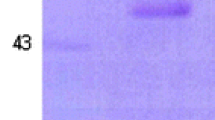Abstract
The changes of oxidative metabolism were studied in the course of a primary infection of mice with attenuated strain ofFrancisella tularensis. Metabolic stimulation of peritoneal cells is associated with a significant increase in spontaneous tetrazolium derivative reduction, the production of superoxide anion and hydrogen peroxide on day 5 after the immunization. The enhancement of superoxide dismutase precedes the increase in superoxide anion secretion. The splenic cells of immunized mice obtained on day 3 andin vitro pulsed by tularemic antigen secreted lymphokins(s) that could induce a metabolic stimulation. The treatment of resting splenic cells with hydrogen peroxide induces the secretion of interferon activity. The changes of oxidative metabolism that appear early after the infection seem to be related to a sequential activation of cells and probably have a regulatory role in the induction of immune defence againstF. tularensis.
Similar content being viewed by others
References
Antonelli G., Amicucci P., Cefaro A., Ausiello C., Malavasi F., Dianzani F.: Mechanism of human interferon-γ production: Involvement of β-2-microglobulin.Cell. Immunol. 115, 156–164 (1988).
Agro A.F., Conti P., Cifone M.G., Angeletti P.U., Rotilio G.: Effect of hydrogen peroxide on lymphocytes, pp. 276–280 in W.H. Bannister, J.V. Bannister (Eds.):Biological and Clinical Aspects of Superoxide and Superoxide Dismutase. Elsevier North Holland, New York 1980.
Beauchamp C.O., Fridovich I.: Superoxide dismutase: Improved assay and assay applicable to acrylamide gels.Anal. Biochem. 44, 276–287 (1971).
Cohen M.S., Britigan B.E., Hassett D.J., Rosen G.M.: Phagocytes, O2 reduction and hydroxyl radical.Rev. Infect. Dis. 10, 1088–1095 (1988).
Gagnon L., Filion L. G., Dubois C., Rola-Plesczynski M.: Leukotrienes and macrophage activation: Augmented cytotoxic activity and enhanced interleukin 1, tumor necrosis factor and hydrogen peroxide production.Agents & Actions 26, 140–147 (1989).
Gallagner B., Curtis G.: The superoxide anion in lymphocyte transformation.Immunol. Lett. 8, 329–333 (1984).
Hashimoto S., Nomoto K., Yokokura T.: The role of superoxide anion and lysosomal enzymes in anti-listerial activity of elicited peritoneal macrophages.Scand. J. Immunol. 24, 429–436 (1986).
Huang J.S., Monk P.N., Downes C.P., Whetton A.D.: Platelet-activating factor-induced hydrolysis of phosphatidylinositol 4,5-bisphosphate stimulates the production of reactive oxygen intermediates in macrophages.Biochem. J. 249, 839–845 (1988).
Karttunen R., Andersson G., Ekre H.T., Juutinen K., Surcel H., Syrjälä H., Herva E.: Interleukin 2 and gamma interferon production interleukin 2 receptor, expression and DNA synthesis induced by tularemia antigenin vitro after natural infection or vaccination.J. Clin. Microbiol. 25, 1074–1078 (1987).
Kaufmann S.H.E., Brinkmann V.: Attempts to characterize the T-cell population and lymphokine involved in the activation of macrophage oxygen metabolism in murine listeriosis.Cell. Immunol. 88, 545–550 (1984).
Kharazmi A., Nielsen H., Bandtzen K.: Recombinant interleukin 1 α and β prime human monocyte superxide production but have no effect on chemotaxis and oxidative burst response of neutrophils.Immunobiol. 177, 32–39 (1988).
Libich J.:Tularemia. Avicenum Medical Press, Prague 1981.
Lokaj J., Oburková P.: Determination of tetrazolium reductase activity of leukocytes (INT-test). (In Czech).Imunol. zprav. 6, 40–42 (1975).
Macela A., Kovářová H., Kopecký J., Propper P.: Interaction ofFrancisella tularensis with the immunoregulatory system of mice, pp. 287–288 in J. Rýc, J. Franěk (Eds.):Bacteria and the Host. Avicenum Medical Press, Prague 1986.
Mauël J., Buchmüller-Rouiler Y.: Effect of lipopolysaccharide on intracellular killing ofLeishmania enriettii and correlation with macrophage oxidative metabolism.Eur. J. Immunol. 17, 203–208 (1987).
McCord J., Frichovich I.: Superoxide dismutase—an enzymic function for erythrocuprein (Hemocuprein).J. Biol. Chem. 244, 6046–6055 (1969).
Melinn M., McLaughlin H.: Nitroblue tetrazolium reduction in lymphocytes.J. Leukocyte Biol. 41, 325–329 (1976).
Munakate T., Semba U., Shibuya Y., Kuwano K., Akagi M., Arai S.: Induction of interferon-γ production by human natural killer cells stimulated by hydrogen peroxide.J. Immunol. 134, 2449–2455 (1985).
Nathan C.F.: Interferon- and macrophage activation in cell-mediated immunity, pp. 165–184 in R.S. Steiman, R.J. North (Eds.):Host Resistance Mechanisms to Infectious Agents, Tumors and Allografts. The Rockefeller University Press, New York 1986.
Reed S.G., Nathan C.F., Pihl D.L., Rodricks P., Shanebeck K., Conlon P.J., Grabstein K.H.: Recombinant granulocyte/macrophage colony-stimulating factor activates macrophages to inhibitTrypanosoma cruzi and release hydrogen peroxide.J. Exp. Med. 166, 1734–1746 (1987).
Stulík J., Černá J., Kovářová H., Macela A.: Protein heterogeneity ofFrancisella tularensis: Detection of proteins with antigenic determinants.Folia Microbiol. 34, 316–323 (1989).
Van Furth R., Van Dissel J.T.: Interferon-γ does not enhance the bactericidal activity of murine macrophages.Agents & Actions 26, 158–159 (1989).
Wahl S.M., McCartney-Francis N., Hunt D.A., Smith P.D., Wahl L.M., Katona I.M.: Monocyte interleukin 2 receptor gene expression and interleukin 2 augmentation of microbicidal activity.J. Immunol. 139, 1342–1347 (1987).
Wing E.J., Ampel N.M., Waheed A., Shadduck R.K.: Macrophage colony-stimulating factor (M-CSF) enhances the capacity of murine macrophages to secrete oxygen reduction products.J. Immunol. 135, 2052–2056 (1985).
Wong G.H.W., Goeddel D.V.: Induction of manganeous superoxide dismutase by tumor necrosis factor: Possible protective mechanism.Science 242, 941–944 (1988).
Worthington Enzyme Manual, pp. 43–45. Worthington Biochemical Corporation, Freehold (New Jersey) 1972.
Author information
Authors and Affiliations
Rights and permissions
About this article
Cite this article
Kovářová, H., Macela, A. & Stulík, J. The production of oxygen metabolites and their possible regulatory role in the course of tularemia infection. Folia Microbiol 35, 413–422 (1990). https://doi.org/10.1007/BF02821410
Received:
Issue Date:
DOI: https://doi.org/10.1007/BF02821410



